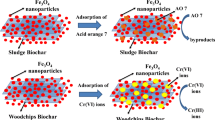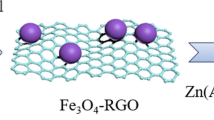Abstract
A two-component material (Fe3O4@CaSiO3) with an Fe3O4 magnetite core and layered porous CaSiO3 shell from calcium nitrate and sodium silicate was synthesized by precipitation. The structure, morphology, magnetic properties, and composition of the Fe3O4@CaSiO3 composite were characterized in detail, and its adsorption performance, adsorption kinetics, and recyclability for Cu2+, Ni2+, and Cr3+ adsorption were studied. The Fe3O4@CaSiO3 composite has a 2D core–layer architecture with a cotton-like morphology, specific surface area of 41.56 m2/g, pore size of 16 nm, and pore volume of 0.25 cm3/g. The measured magnetization saturation values of the magnetic composite were 57.1 emu/g. Data of the adsorption of Cu2+, Ni2+, and Cr3+ by Fe3O4@CaSiO3 fitted the Redlich–Peterson and pseudo-second-order models well, and all adsorption processes reached equilibrium within 150 min. The maximum adsorption capacities of Fe3O4@CaSiO3 toward Cu2+, Ni2+, and Cr3+ were 427.10, 391.59, and 371.39 mg/g at an initial concentration of 225 mg/L and a temperature of 293 K according to the fitted curve with the Redlich–Peterson model, respectively. All adsorption were spontaneous endothermic processes featuring an entropy increase, including physisorption, chemisorption, and ion exchange; among these process, chemisorption was the primary mechanism. Fe3O4@CaSiO3 exhibited excellent adsorption, regeneration, and magnetic separation performance, thereby demonstrating its potential applicability to removing heavy metal ions.













Similar content being viewed by others
References
Akhavan O, Azimirad R, Safa S, Hasani E (2011) CuO/Cu(OH)2 hierarchical nanostructures as bactericidal photocatalysts. J Mater Chem 21:9634–9640
Al-Saydeh SA, El-Naas MH, Zaidi SJ (2017) Copper removal from industrial wastewater: a comprehensive review. J Ind Eng Chem 56:35–44
Awual MR (2015) A novel facial composite adsorbent for enhanced copper (II) detection and removal from wastewater. Chem Eng J 266:368–375
Awual MR, Hasan MM, Khaleque MA, Sheikh MC (2016) Treatment of copper (II) containing wastewater by a newly developed ligand based facial conjugate materials. Chem Eng J 288:368–376
Burakov AE, Galunin EV, Burakova IV, Kucherova AE, Agarwal S, Tkachev AG, Gupta VK (2018) Adsorption of heavy metals on conventional and nanostructured materials for wastewater treatment purposes: a review. Ecotoxicol Environ Saf 148:702–712
Chi Y, Yuan Q, Li Y, Tu J, Zhao L, Li N, Li X (2012) Synthesis of Fe3O4@SiO2-Ag magnetic nanocomposite based on small-sized and highly dispersed silver nanoparticles for catalytic reduction of 4-nitrophenol. J Colloid Interface Sc 383:96–102
Deng Y, Qi D, Deng C, Zhang X, Zhao D (2008) Superparamagnetic high-magnetization microspheres with an Fe3O4@SiO2 core and perpendicularly aligned mesoporous SiO2 shell for removal of microcystins. J Am Chem Soc 130:28–29
Deroubaix G, Marcus P (1992) X-ray photoelectron spectroscopy analysis of copper and zinc oxides and sulphides. Surf Interface Anal 18:39–46
Doula MK (2009) Simultaneous removal of Cu, Mn and Zn from drinking water with the use of clinoptilolite and its Fe-modified form. Water Res 43:3659–3672
Feng Q, Wu D, Zhao Y, Wei A, Wei Q, Fong H (2018) Electrospun AOPAN/RC blend nanofiber membrane for efficient removal of heavy metal ions from water. J Hazard Mater 344:819–828
Fu F, Xie L, Tang B, Wang Q, Jiang S (2012) Application of a novel strategy-advanced Fenton-chemical precipitation to the treatment of strong stability chelated heavy metal containing wastewater. Chem Eng J 189–190:283–287
Futalan CM, Kan CC, Dalida ML, Pascua C, Wan MW (2011) Fixed-bed column studies on the removal of copper using chitosan immobilized on bentonite. Carbohydr Polym 83:697–704
Ge J, Hu Y, Biasini M, Beyermann WP, Yin Y (2007) Superparamagnetic magnetite colloidal nanocrystal clusters. Angew Chem Int Ed 46:4342–4345
Guan W, Zhao X (2016) Fluoride recovery using porous calcium silicate hydrates via spontaneous Ca2+, and OH− release. Sep Purif Technol 165:71–77
Guo Z, Zhang J, Liu H, Kang Y, Yu J, Zhang C (2017) Optimization of the green and low-cost ammoniation-activation method to produce biomass-based activated carbon for Ni(II) removal from aqueous solutions. J Clean Prod 159:38–46
Hu X, Yang J, Zhang J (2011) Magnetic loading of TiO2/SiO2/Fe3O4 nanoparticles on electrode surface for photoelectrocatalytic degradation of diclofenac. J Hazard Mater 196:220–227
Hua M, Zhang S, Pan B, Zhang W, Lv L, Zhang Q (2012) Heavy metal removal from water/wastewater by nanosized metal oxides: a review. J Hazard Mater 211–212:317–331
Kalaivani SS, Muthukrishnaraj A, Sivanesan S, Ravikumar L (2016) Novel hyperbranched polyurethane resins for the removal of heavy metal ions from aqueous solution. Process Saf Environ Prot 104:11–23
Lee T (2012) Removal of heavy metals in storm water runoff using porous vermiculite expanded by microwave preparation. Water Air Soil Pollut 223:3399–3408
Li G, Shen B, He N, Ma C, Elingarami S, Li Z (2011) Synthesis and characterization of Fe3O4@SiO2 core–shell magnetic microspheres for extraction of genomic DNA from human whole blood. J Nanosci Nanotechnol 11:10295–10301
Li G, Wang B, Sun Q, Xu WQ, Han Y (2017a) Adsorption of lead ion on amino-functionalized fly-ash-based SBA-15 mesoporous molecular sieves prepared via two-step hydrothermal method. Microporous Mesoporous Mater 252:105–115
Li N, Fu F, Lu J, Ding Z, Tang B, Pang J (2017b) Facile preparation of magnetic mesoporous MnFe2O4@SiO2-CTAB composites for Cr(VI) adsorption and reduction. Environ Pollut 220:1376–1385
Lin Z, Zhang Y, Chen Y, Qian H (2012) Extraction and recycling utilization of metal ions (Cu2+, Co2+, and Ni2+) with magnetic polymer beads. Chem Eng J 200–202:104–112
Liu L, Wu J, Li X, Ling Y (2013) Synthesis of poly(dimethyldiallylammonium chloride-co-acrylamide)-graft-triethylenetetramine–dithiocarbamate and its removal performance and mechanism of action towards heavy metal ions. Sep Purif Technol 103:92–100
Liu L, Li T, Yang G, Wang Y, Tang A, Ling Y (2017a) Synthesis of thiol-functionalized mesoporous calcium silicate and its adsorption characteristics for heavy metal ions. J Environ Chem Eng 5:6201–6215
Liu T, Han X, Wang Y, Yan L, Du B (2017b) Magnetic chitosan/anaerobic granular sludge composite: synthesis, characterization and application in heavy metal ions removal. J Colloid Interface Sci 508:405–414
Liu G, Chen L, Yu J, Feng N, Meng J, Fang F, Wang L, Wan H, Guan G (2018a) Interphase strengthening birnessite MnO2 coating on three-dimensional Ni foam for soot removal. Appl Catal A 568:157–167
Liu L, Liu J, Li T, Yang G, Tang A, Ling Y (2018b) Adsorption efficiency, thermodynamics, and kinetics of amino-functionalized mesoporous calcium silicate for the removal of heavy metal ions. Desalin Water Treat 107:165–181
Long J, Luo X, Yin X, Wu X (2016) An ion-imprinted polymer based on the novel functional monomer for selective removal of Ni(II) from aqueous solution. J Environ Chem Eng 4:4776–4785
Mehrali M, Shirazi SFS, Baradaran S, Mehrali M, Metselaar HSC, Kadri NAB, Osman NAA (2014) Facile synthesis of calcium silicate hydrate using sodium dodecyl sulfate as a surfactant assisted by ultrasonic irradiation. Ultrason Sonochem 21:735–742
Melita L, Gumrah F, Amareanu M (2014) Porous polymer membranes used for wastewater treatment. Membr Water Treat 5:147–170
Mostafa NY, Kishar EA, Abo-El-Enein SA (2009) FTIR study and cation exchange capacity of Fe3+ and Mg2+ substituted calcium silicate hydrates. J Alloys Compd 473:538–542
Okano K, Uemoto M, Kagami J, Miura K, Aketo T, Toda M, Honda K, Ohtake H (2013) Novel technique for phosphorus recovery from aqueous solutions using amorphous calcium silicate hydrates (A-CSHs). Water Res 47:2251–2259
Qi G, Lei X, Li L, Sun Y, Yuan C, Wang B, Yin L, Xu H, Wang Y (2015) Preparation and evaluation of a mesoporous calcium-silicate material (MCSM) from coal fly ash for removal of Co (II) from wastewater. Chem Eng J 279:777–787
Raval NP, Shah PU, Shah NK (2016) Adsorptive removal of nickel(II) ions from aqueous environment: a review. J Environ Manag 179:1–20
Shao N, Tang S, Liu Z, Li L, Yan F, Liu F, Li S, Zhang Z (2018) Hierarchically structured calcium silicate hydrate-based nanocomposites derived from steel slag for highly efficient heavy metal removal from waste water. ACS Sustain Chem Eng 6:14926–14935
Shen W, Yi M, Xiao T, Ai Z (2016) Magnetic Fe3O4-FeB nanocomposites with promoted Cr (VI) removal performance. Chem Eng J 285:57–68
Shi S, Fan Y, Huang Y (2013) Facile low temperature hydrothermal synthesis of magnetic mesoporous carbon nanocomposite for adsorption removal of ciprofloxacin antibiotics. Ind Eng Chem Res 52:2604–2612
Tan IAW, Chan JC, Hameed BH, Lim LLP (2016a) Adsorption behavior of cadmium ions onto phosphoric acid-impregnated microwave-induced mesoporous activated carbon. J Water Process Eng 14:60–70
Tan P, Hu Y, Bi Q (2016b) Competitive adsorption of Cu2+, Cd2+ and Ni2+ from an aqueous solution on graphene oxide membranes. Colloids Surf A Physicochem Eng Asp 509:56–64
Tao S, Wang C, Ma W, Wu S, Meng C (2012) Designed multifunctionalized magnetic mesoporous microsphere for sequential sorption of organic and inorganic pollutants. Microporous Mesoporous Mater 147:295–301
Thuan TV, Quynh BTP, Nguyen TD, Ho VTT, Bach LG (2017) Response surface methodology approach for optimization of Cu2+, Ni2+ and Pb2+ adsorption using KOH-activated carbon from banana peel. Surf Interfaces 6:209–217
Tits J, Wieland E, Müller CJ, Landesman C, Bradbury MH (2006) Strontium binding by calcium silicate hydrates. J Colloid Interface Sci 300:78–87
Wang Y, Huang Q (2017) Simultaneous removal of cadmium, zinc and manganese using electrocoagulation: influence of operating parameters and electrolyte nature. J Environ Manag 204:394–403
Wang H, Ren ZJ (2014) Bioelectrochemical metal recovery from wastewater: a review. Water Res 66:219–232
Wang Y, Feng Y, Zhang X-F, Zhang X, Jiang J, Yao J (2018) Alginate-based attapulgite foams as efficient and recyclable adsorbents for the removal of heavy metals. J Colloid Interface Sci 514:190–198
Wu J, Zhu YJ, Chen F (2013) Ultrathin calcium silicate hydrate nanosheets with large specific surface areas: synthesis, crystallization, layered self-assembly and applications as excellent adsorbents for drug, protein, and metal ions. Small 9:2911–2925
Wu X, Wang W, Li F, Khaimanov S, Tsidaeva N, Lahoubi M (2016) PEG-assisted hydrothermal synthesis of CoFe2O4 nanoparticles with enhanced selective adsorption properties for different dyes. Appl Surf Sci 389: 1003–1011
Xia W, Chang J (2008) Preparation and the phase transformation behavior of amorphous mesoporous calcium silicate. Microporous Mesoporous Mater 108:345–351
Yu J, Zhang J, Song S, Liu H, Guo Z, Zhang C (2019) Removal of Ni(II) from aqueous solutions using activated carbon with manganese formate hydrate in-situ modification. Colloids Surf A Physicochem Eng Asp 560:84–91
Zhang J, Zhu Y (2014) Synthesis and characterization of CeO2-incorporated mesoporous calcium-silicate materials. Microporous Mesoporous Mater 197:244–251
Zhang X-L, Niu H-Y, Li W-H, Shi Y-L, Cai Y-Q (2011) A core-shell magnetic mesoporous silica sorbent for organic targets with high extraction performance and anti-interference ability. Chem Commun 47:4454–4456
Zhao X, Liu C (2018) Efficient removal of heavy metal ions based on the optimized dissolution diffusion-flow forward osmosis process. Chem Eng J 334:1128–1134
Zhao J, Zhu Y-J, Wu J, Zheng J-Q, Zhao X-Y, Lu B-Q, Chen F (2014) Chitosan-coated mesoporous microspheres of calcium silicate hydrate: environmentally friendly synthesis and application as a highly efficient adsorbent for heavy metal ions. J Colloid Interface Sci 418:208–215
Zhao K, Chen T, Li D, Zhang X, Song H, Wei J (2015a) Preparation and characterization of mesoporous calcium silicate grafted polypropylene non-woven fabric. Mater Lett 141:110–113
Zhao X, Li W, Zhang S, Liu L, Liu S (2015b) Hierarchically tunable porous carbon spheres derived from larch sawdust and application for efficiently removing Cr (III) and Pb (II). Mater Chem Phys 155:52–58
Zhao J, Liu J, Li N, Wang W, Nan J, Zhao Z, Cui F (2016) Highly efficient removal of bivalent heavy metals from aqueous systems by magnetic porous Fe3O4-MnO2: adsorption behavior and process study. Chem Eng J 304:737–746
Acknowledgements
This research was supported by the National Nature Science Foundation of China (Grant No. 51378201) and the Scientific Research Fund of Hunan Provincial Education Department (Grant No. 16A069).
Author information
Authors and Affiliations
Corresponding author
Additional information
Responsible editor: Tito Roberto Cadaval Jr
Publisher’s note
Springer Nature remains neutral with regard to jurisdictional claims in published maps and institutional affiliations.
Electronic supplementary material
ESM 1
(DOCX 307 kb)
Rights and permissions
About this article
Cite this article
Liu, L., Liu, J., Zhao, L. et al. Synthesis and characterization of magnetic Fe3O4@CaSiO3 composites and evaluation of their adsorption characteristics for heavy metal ions. Environ Sci Pollut Res 26, 8721–8736 (2019). https://doi.org/10.1007/s11356-019-04352-6
Received:
Accepted:
Published:
Issue Date:
DOI: https://doi.org/10.1007/s11356-019-04352-6




